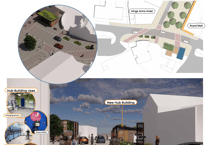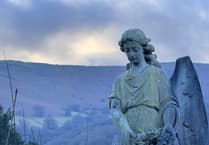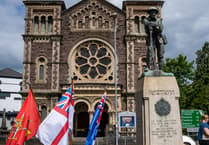TIMES change. Sometimes for the best, sometimes for the worst, but nothing stays the same forever. Take Tudor Street and Mill Street for example. They survived two World Wars, and in the case of the latter, the great flood of 1931, but neither would survive the planner’s dream and bombastic swing of the wrecking ball.
Designated as slums, the houses were tore down and the communities were moved on, as history was reduced to rubble and a little bit of Abergavenny’s run-down character and ramshackle charm was wiped out and replaced with…. something new.
The Tudor Street and Mill Street of today bear little resemblance to the way they once looked. For those of us born in the aftermath of Abergavenny’s great sea change it’s difficult to visualize the winding streets, towering dwellings, cobbled pathways, beaten up charm and splendid decay of the numerous boozers which now and forever have become part of a vanished Abergavenny.
Fortunately, we can till capture a little bit of that old time magic through fading photographs and the scattered recollections of those who lived in the streets of old Abergavenny.
Former Mill Street resident Tom Dodd kindly supplied the Chronicle with a few rare pics of his old stomping ground.
Like Tudor Street, snapshots of Mill Street from back in the day are thin on the ground and these beauties are a real eye-opener.
Tom left Abergavenny for pastures new in the early 1970s, but the boy who was born and bred in Mill Street has a special place in his heart for the old family home.
The 77-year-old recalls, “I was born on the couch in 18 Mill Street in 1941. The house was a simple one up one down with no electricity, no oven and an outside toilet. By today’s standards there wasn’t a lot of creature comforts but back then we didn’t know any different and so we didn’t miss what we never had.
“Of course, in those days we were also on war rations and we used food coupons to purchase what we needed. Which included one bar of Cadburys a week. At the time it seemed like a luxury but I think kids today would find it had to limit themselves to one bar of chocolate a day!”
Tom added, “I suppose we’d be classed as living in poverty but we were always clean and one thing about Mill Street, it may sound like a cliche, but no-one ever locked their doors. You could go from house to house and always feel very welcome.”
Tom, whose mother Doris Poulson (known locally as Deana) had to clamber through a hole in the ceiling of her home in 1931 when she was 11 to escape the great Mill Street flood, added, “For the first four years of my life I rarely saw my father Howell Dodd because he was fighting in the Second World War, but I do remember one day towards the end of the conflict an American soldier walking down our street.
“In Mill Street there was no pavement and the door opened directly onto the road. Anyhow, my mum pushed me out of the front door and said to ask the solider, ‘Have you got any gum chum?’
“He didn’t have any gum but he did give me a a bar of chocolate for my efforts” recalled Tom.
Tom was the eldest of three brothers. His youngest sibling Richard would go on to become Mayor of Abergavenny as would Richard’s own daughter Sam Dodd.
Tom explained, “Sadly both Richard and my other brother Alan died from illness when they were quite young but I remember when we were kids we’d spend a lot of time playing in Castle Meadows because it was only a stone’s throw away from Mill Street
“We’d only be five or six but we were allowed to wander off down the river on our own for hours on end. We’d also spend a lot of time messing around in the wool bales that came form the wool stores at the Castle end of Mill Street.”
Remembering the characters of his youth, one name stands out above the rest for Tom, and that was his grandmother Olive Poulsom.
“Ollie was quite a lady” recalled Tom. “She was known throughout town as the lady you’d call on to lay the dead out. When anyone died they’d give Ollie a shout and for a few shillings she’d make them look presentable in their coffin. A guy called Arthur Graham who was a cabinet maker and undertaker would make up the coffin and Ollie would lay them out.”
Tom whose namesake and uncle, Tom Poulsom, was a well-known man about town and the Head Porter in The Angel Hotel for many years, told the Chronicle “Our family grocer was Basil Jones. When I was 13 I’d deliver groceries for Basil all over town on my bike. There was no gears in those days so it was hard work. Especially going up the Mardy.”
Tom who went to Castle Street Infants, before attending Hereford Boys School, and then moving on to Grofield Secondary, left school at the age of 15 with no qualifications and began an apprenticeship at Seargeant Bros, Printers, Bookbinders and Paperworkers.
Tom told the Chronicle, “At the time Seargeants was probably one of the biggest employers in Abergavenny.
“I was apprenticed there as a bookbinder from January 1 1957 for six years and my brother Alan also for the same period at a later date.
“Back then New Year’s Day wasn’t a holiday so everyone was expected to work in the wake of New Year’s Eve, hungover or not.”
After working at Seargeants for eight years Tom got a dose of cabin fever and decided to try his hand at something new.
“I got fed up and decided to get some O - Levels. So I went to Pontypool and that’s what I did,” explained Tom.
Proving it’s never to late to get an education, Tom, who had decided he wanted to work outdoors, attended a one year course at Coleg Harlech and a teacher’s training course in Birmingham for three years before going on to enjoy a successful career as an outdoors teacher at various residential centers across the UK.
Tom, who now lives in Blaenau Ffestiniog rarely visits Abergavenny but remains surprised when he does just how much it has changed over the years.
“I know there’s a lot of sentiment attached to the old areas of Abergavenny such as Mill Street and Tudor Street but when our family was moved to Park Lane it was wonderful. I mean we had all mod cons, a view of the park and it was just worlds apart from where we came from,” said Tom.
“You have to remember in Mill Street the houses were in a rare old state. They needed a lot of renovation. And who was going to supply the money for that? It was a great place but so was Park Lane. And I’ve got loads of great memories from there as well, but that’s a story for another day.”
If you’ve got any engaging and striking pictures from the past that could do with an airing and benefit from the oxygen of publicity, then why let them linger and gather dust in the drawer a day longer? Send them to [email protected]. Alternatively you can do things the old fashioned way and pick up the telephone and ring Tim Butters on 01873 852187 (30).




